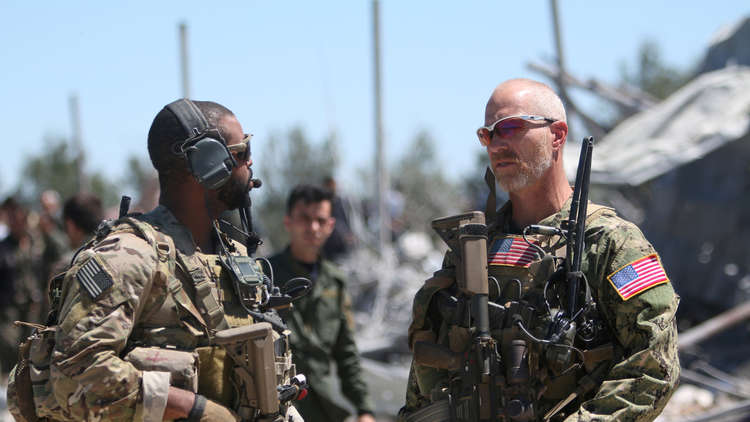The security operations of the US-led Global Coalition to Defeat ISIS, with the assistance of the Syrian Democratic Forces (SDF), have pursued terrorist elements in the Deir ez-Zor and Hasakeh governorates since late August. With a view to secure areas under the control of the SDF in northeast Syria and maintain its influence in those areas against threats from pro-Iranian Shiite militias in Deir ez-Zor, these security operations are aimed at affirming US commitment to combat terrorism, as well as to reposition the US in Syria, with the creation of a third base in the city of Qamishli, Hasakah. The US-led Global Coalition Forces security operations continued into the early days of September, to pursue ISIS leaders and elements in northeastern Syria under the control of the SDF.
Fears of the group’s ability to consolidate its influence in Syria escalated following ISIS’s attempt to break into Gweiran prison last January. This prompted the US to carry out a number of security operations to pursue ISIS leaders, most notably Abu Ibrahim al-Hashimi al-Qurshi, in an air raid last February.
According to local media reports, the geographical scope of Global Coalition operations was concentrated around Deir ez-Zor and Hasakeh, areas controlled by the SDF. The first was on September 1 in the village of Al-Takihi, in rural Deir ez-Zor, to arrest the leader of the Hisbah apparatus, but he managed to escape before he was killed. According to the Syrian Observatory for Human Rights, the second operatin was on September 3, to arrest leaders of the organization in the Hawi area of Shahil, east of Deir ez-Zor. On August 30 and 31, the Global Coalition, in cooperation with SDF forces, carried out an operation with the support of the coalition’s aircrafts in Hasakah, specifically in the vicinity of the prison in Gwieran, which houses leaders and members of ISIS, resulting in the arrest of three ISIS members, according to local media reports.
Despite its diverse resources, the Global Coalition has recently relied on attacks by air born forces, carrying out two operations less than 48 hours apart, to arrest influential ISIS members. While attacks by air born troops are less common in counter-terrorism operations, they have been employed in operations with precise objectives, such as targeting ISIS leaders Abu Ibrahim al-Hashimi, and Hani al-Kurdi, on June 17, in northwest Syria. Last July, US forces participating in the Global Coalition targeted Maher al-Aqal, another ISIS leader in Syria using a drone, which is the same method it has used to target “the Guards of Religion” terrorist group, targeting Yemeni Abu Hamza last June.
The security campaign by Coalition forces, in cooperation with SDF forces, are part of a multi sided effort to reestablish security in and around Al-Hawl Camp, which houses ISIS operatives and their families, after several killings occurred in the camp – between January 2021 and June 2022- estimated by the UN to number 106. SDF forces were able to seize some militant elements inside the camp and dismantle several cells. There have been concerns that some ISIS militants and their families could escape from the camp, and an ISIS plan to storm the camp had been thwarted following the arrest of ISIS cells.
Deir ez-Zor, it is worth noting, is an area contested by SDF forces, supported by Coalition forces on one hand, and the Syrian regime supported by Iranian militias, on the other. Coalition operations have been taking place at the same time the US has been striking the positions of Iranian militias affiliated with the Revolutionary Guard, in retaliation for the attack on the US base in Al-Tanaf.
The data regarding ISIS operations posted on the A’maq news agency shows a fluctuation in the number of ISIS operations in Syria between January and September. The highest rate was in January, at 31 operations. There were multiple confrontations between ISIS and SDF forces during this time, following the attempted break out of Gweiran prison. ISIS activity declined to 18 operations in February, and 12 operations in March, before increasing in April to 29 operations. This spike is linked to the Syrian division’s response to the call by ISIS central command to retaliate in a campaign of revenge for the assassination of an ISIS leader and spokesman. ISIS attacks gradually declined during May to 13 operations, and 7 operations in June, the lowest rate during this period.We then observe an upward trend in July, with 22 operations, 26 operations in August, and 7 operations during the first 5 days of September, the same number of operations during the whole month of June.
The International Coalition appears to be expanding its use of air born troops in its operations from in Deir ez-Zor and other regions in northeast Syria,which are also under the control of the SDF, while using this type of operation sparingly in other regions of Syria, deemed to be hostile.
It can be argued there are two main objectives for the growing use of this type of operation against cadre and file ISIS militants, not just leaders. The first objective is to break up terrorist cells, make arrests , and thereby extract information on the organization’s operations, sources of funding and the number and composition of these cells. This information helps update intelligence and develop a strategy for the dismantling of these cells.
The second objective is to avoid civilian casualties. The use of this type of operation reduces civilian casualties compared to unmanned aerial vehicles that shell homes where terrorist elements are thought to be hiding. This is consistent with US Biden Administration’s review of drone use policy, that restricted aerial shelling given the intense domestic and foreign criticism of civilian casualties caused by airstrikes in counter-terrorism operations.
The geographical scope of these operations appears aimed at undermining ISIS presence and activity in northeastern Syria, in view of indications it has been able to adapt and regroup following the loss of its last stronghold in the Baghuz region in 2019.There appear to be fears
of future coordinated and complex operations by ISIS, as the attempt to break into Gweiran prison and other operations in the Syrian Badya region reflect an evolution in ISIS’s operational and funding capabilities.
The launching of attacks against Iranian militias in Deir ez-Zor, in tandem with security operations to pursue ISIS elements in the same governorate, indicates the US wishes to reduce the level of threats in northeastern Syria and secure SDF control. This comes in response to increased activity from ISIS and the deployment of Iranian militias to the area. There are fears the militias will expand their presence and influence in the area while Russia is preoccupied with the war in Ukraine. Media reports indicate Iranian militias in Deir ez-Zor were transporting rocket and cannon platforms to the southern parts of the city, despite the constant oversight of the Coalition’s drones.
The recent operations also reflect US commitment, expressed by President Biden at the Jeddah Security and Development Summit in Saudi Arabia, to continue combating terrorism, specifically ISIS. The US counter-terrorism strategy in Syria has faced criticism for not developing a clear response to the ISIS threats there, which has allowed it to achieve some level of cohesion and restructuring over the past two years, as reflected by its increased operational activity.
The operations of US forces participating in the International Coalition against ISIS in northeast Syria, may be viewed as part of a repositioning strategy. Syrian reports indicate the US has established its third base in the city of Qamishli in Hasakah, with the aim of securing US interests, specifically with regard to securing the oil fields, in the face of an expanding presence of Iranian militias, and growing ISIS activity. The threat from ISIS in the area appears to be increasing, as it seeks to benefit from contested authority in various areas to infiltrate and establish a presence. ISIS has also recently displayed improvement in its structure, adopting a decentralized mode of operations in response to imperatives on the ground.


